Norwich Electric Tramways Company
History
Norwich's 3ft 6ins-gauge electric tramway, which was owned and operated by the Norwich Electric Tramways Company Limited, opened on the 30th July 1900. The NETCo was a subsidiary of the New General Traction Company Limited, which also owned tramways in Coventry (opened in 1895) and in Douglas on the Isle of Man (opened in 1896); as was the case in Norwich, the NGTCo operated both these tramways via subsidiaries, namely, the Coventry Electric Tramways Company Limited and the Douglas Southern Electric Tramways Limited.
The company had acquired the powers to construct the tramway in July 1897, and also agreed a series of road improvements with Norwich City Council (sharing the cost), the latter having the right to purchase the tramway after 35 years, i.e., in 1932.
New lines were opened throughout 1900, the last one, in December — the Unthank Road line — taking the system to its final form (bar minor modifications); although extensions were contemplated prior to the Great War, the conflict put paid to them, and they were not revived afterwards. The system was in fact surprisingly complex for such a small city, with no fewer than eleven lines radiating from the centre, as well as three additional lines connecting six of the radial lines.
At its maximum, the Norwich system extended to 15.16 miles, comprising lines running: westwards along Newmarket Road to its junction with Unthank Road; northwards from Orford Place then northwestwards along Earlham Road to Cemetery Gates, with a branch southwestwards from St Giles Gate along Unthank Road to its junction with Mile End Road, as well as a connecting line southwards from St Giles Gate along Chapel Field Road to the Newmarket Road line; northwestwards along Dereham Road to its junction with Merton Road, with a connecting line southwards along Heigham Road to the Earlham Road line; northwards from Dereham Road past City Station and along Aylsham Road to its junction with Vicarage Road; northeastwards along Magdalen Road and Denmark Road to Silver Road, with a connecting line westwards at Magdalen Gates along Magpie Road to the Aylsham Road line; southeastwards along Prince of Wales Road and Thorpe Road to the Redan Public House, with a branch leading northeastwards along Riverside Road and Gurney Road to Mousehold Heath; southwards along King Street to Trowse Station; southeastwards from St Stephen's Gate along Queens Road to meet the Trowse line, with a branch running southwards along City Road to its junction with Sunny Hill.
Many of the tramway services and routes ran across the city, i.e., they ran from the terminus of one line through the city and out to the terminus of another line.
The company was unusual in having permission to use trailers (of which it had ten), though like elsewhere, they did not last long, the Board of Trade regulations requiring a brakesman and a conductor on each trailer, which effectively nullifying any economies.
Like many tramways, Norwich's suffered during the Great War from a loss of men to the armed forces, which coupled with an inability to buy spares or new equipment (track and vehicles), led to a regime of minimal maintenance. The line along King Street was in fact taken up in mid 1918 to be used to build a light railway into an aerodrome and armaments factory at Mousehold. This left Trowse without a service until the autumn of 1919, when a connection was laid via Bracondale.
The early 1920s were to prove a difficult time for the tramway, although still carrying large numbers of passengers, costs were greatly increased (post-war inflation) and there was the looming spectre of significant track renewal. The company nevertheless found the money to carry out track replacement and improvement, as well as to refurbish some of the tram fleet. However, as the city expanded outwards in the 1920s, the company chose to introduce new bus services to connect the growing suburbs to the centre, rather than build new tramlines. It had in fact first introduced a bus service in 1915, though it only lasted until 1918.
The first casualty of the bus expansion was the Aylsham Road line, which was closed on the 19th April 1925, a bus service commencing the following day. New bus services were introduced throughout the late 1920s and into the 1930s, by which time the company, the council and the public all seemed to view the trams as an anachronism that needed to be replaced by comfortable, modern buses. Indeed, Norwich City Council sought to purchase the tramway in 1932, but was prevented from doing so by a concerted campaign by ratepayers (amongst others) who strongly objected to picking up the bill for tramway conversion.
On or shortly before the 1st December 1933, the NETCo was taken over by the Eastern Counties Omnibus Company, and with a bus company now in charge, the writing was most definitely on the wall. The process of line closure was accelerated, and on the 6th June 1935, the company acquired powers to abandon the tramway, having already closed several lines without formal approval. Even as late as 1934, the trams were still carrying 50% more passengers than the buses, but it proved to be their swan song, the last tram of all running on the 10th December 1935.
Uniforms
Photographs taken in the early years of operation show that conductors and motormen wore double-breasted jackets with four pairs of buttons (nickel; see link) — the top pair buttoning between the lapels and the collars — two waist pockets and lapels; the latter were devoid of insignia. Caps were of the drooping-peak type; they bore a narrow hat band (presumably of a contrasting colour), which carried a prominent oval cap badge comprising an employee number on a leather in-lay, surrounded by the full company name, topped off by a lion, all in nickel.
Motormen and conductors were also issued with double-breasted greatcoats with five pairs of buttons, two waist pockets, a breast pocket, and high, fold-over collars; these garments were completely devoid of insignia. Several photos show motormen with material chevrons (two and three stripes are known) on their left upper sleeve, reminiscent of corporal/sergeant stripes; the precise meaning of these is unclear, though they probably denoted seniority or good conduct.
Staff initially had to purchase their own uniforms.
At some point prior to the Great War, possibly as early as the mid-Edwardian era, the caps were changed to a more contemporary peaked type with tensioned crowns (tops); the badge however, remained the same. The jackets remained double-breasted with lapels throughout the life of the tramway, though a more modern cut was used in later years.
Conductors and motormen also wore light-coloured alloy licence badges; these bore a number, with the words 'NORWICH' above, and either 'CONDUCTOR' or 'DRIVER' below, and were usually worn on the bearer's left front at breast level.
Inspectors were initially issued with waistcoats and single-breasted jackets with seven buttons, slit pockets and stand-up collars; the latter were left plain, i.e. were devoid of insignia. Caps were in the same drooping-peak style as tramcar staff, but bore a wide piped hat band; this seems to have born a cap badge that was very similar in form to the cap badge worn by motormen and conductors. However, one individual on the early staff photograph below clearly has script-lettering on his cap (and no cap badge), which probably stated his grade, 'Inspector'. The chief inspector appears to have worn an identical uniform, but without a cap badge, instead having a wide, heavily embroidered hatband. This style of uniform appears to have been fairly quickly replaced, probably as early as 1901, by fairly standard tramway inspector garb, namely: single-breasted jackets with hidden buttons (or more likely an hook and eye affair), all edged in material of a finer quality than the main jacket, and with stand-up collars; the latter probably bore the grade — 'Inspector' or 'Chief Inspector' — in embroidered script lettering. The drooping-peak caps remained unchanged, but now bore a cap badge that was identical in form to those worn by tramcar staff; inspectors cap badges were nickel and bore the grade — 'Inspector'— rather than an employee number, the chief inspector's being gold coloured (probably gilt) and with his grade — 'Chief Inspector' — on a red or green background.
At some point, the drooping-peak caps were superseded by tensioned-crown peaked caps, though exactly when this took place is unknown. By the closing years of the system, the chief inspector (and probably inspectors too) were wearing smart double-breasted overcoats with lapels and braided epaulettes, all devoid of insignia. In the last-day photo below, the chief inspector is wearing a shirt and tie, indicating that the jacket worn underneath must have had lapels rather than stand-up collars.
In common with many tramway systems, women were employed as conductresses during the Great War to replace men lost to the armed services. It would appear that uniforms took some time to be issued, as a studio portrait has survived with the subject wearing a long, double-breasted topcoat rather than a uniform, which would surely have been preferred for a formal portrait, had one been available. The double-breasted topcoats were in a lancer style, with six pairs of plain composite buttons narrowing from top to bottom, the entire garment devoid of insignia. Whilst it is tempting to see the topoats as informal attire, the number of surviving photographs showing them indicate that they were provided by the company. The initial hats appear to have been waterproof bonnets; these bore the standard NETCo cap badge. At some point uniforms were issued; these were single-breasted and lightweight, with a waist belt (with buttons), two waist-level pockets and lapels; the buttons were plain, as were the collars (i.e., no badges were carried). A long matching skirt was also worn. Two main styles of hat were used, probably reflecting summer and winter wear: a dark-coloured, wide-brimmed straw bonnet with a hat band, and a baggy, peaked cap, a style commonly referred to as a motor cap; the usual cap badge was affixed to both styles of hat.
Further reading
For a history of the system see: 'The Tramways of East Anglia — Chapter 6' by R C Anderson; The Light Railway Transport League (1969). For a pictorial history see: 'Norwich Tramways' by David Mackley; Middleton Press (2000).
Images
Motormen and conductors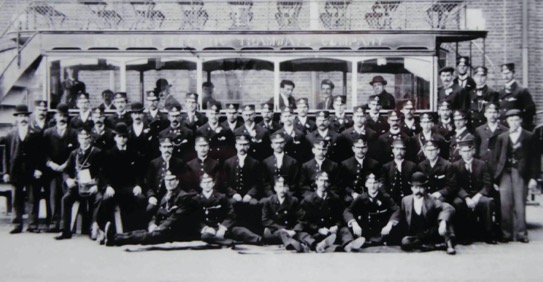
A staff photograph, probably posed outside the Silver Road depot — photo undated, but probably taken in 1900. Photo courtesy of the David Mackley Collection.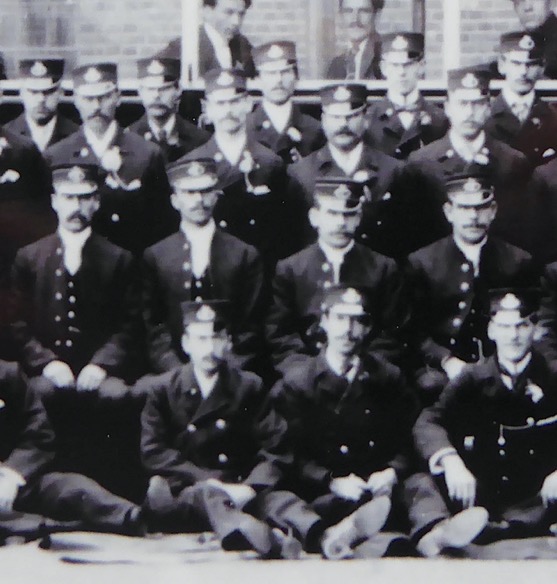
An enlargement of the above photograph showing some of the men. Although most are wearing double-breasted jackets with lapels (32 in total), a significant number (8 in the full photo) are wearing waistcoats and single-breasted tunics with stand-up collars. The latter are also wearing wide, piped hatbands, so they are probably senior staff (i.e., inspectors and the chief inspector).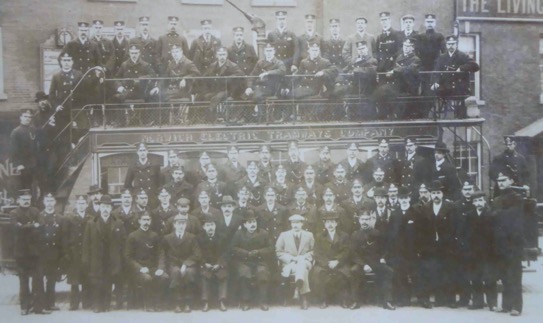
A staff photograph taken at Orford Place, probably about 1901. There are around 52 uniformed motormen and conductors, and 6 senior uniformed staff (inspectors and the chief inspector). Photo courtesy of the David Mackley Collection.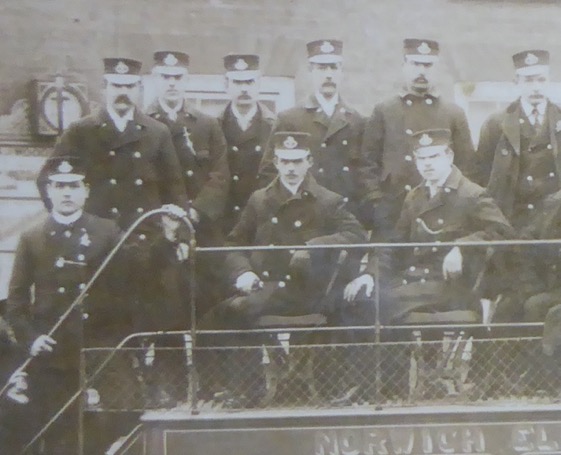
An enlargement of the above photograph showing some of the uniformed staff. Most are wearing double-breasted greatcoats and drooping-peak caps, though one man is without a greatcoat, revealing the double-breasted jacket worn underneath.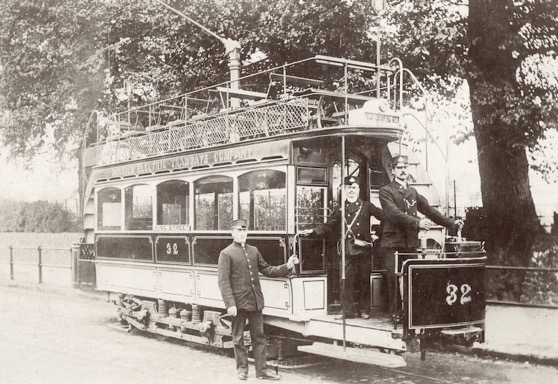
A senior member of staff (possibly the chief inspector), and the crew of a brand-new No 32, pose for the cameraman, possibly at Trowse, in 1900. The car has a 'King Street' window route board, and an indicator (mounted on the canopy) set for 'Trowse'. Author's Collection.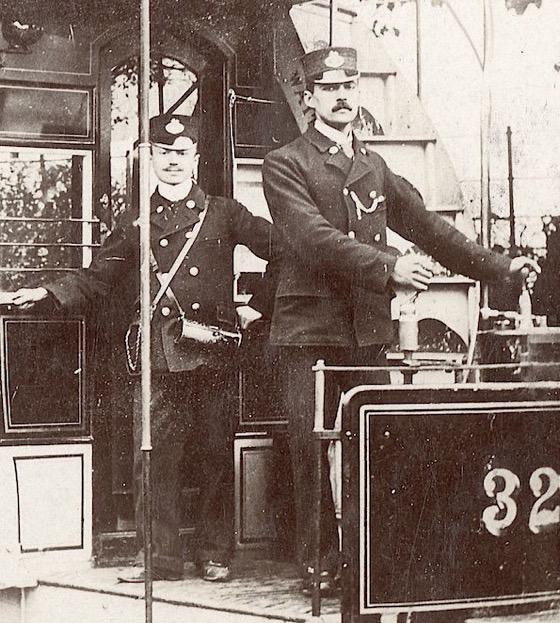
An enlargement of the above photograph showing the conductor and the motorman. The large oval cap badges are clearly seen. 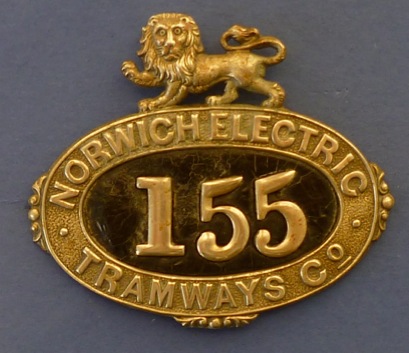
NETCo cap badge — nickel with leather inlay. This badge formerly belonged to Thomas Turner, who started with the NETCo shortly after the Great War, serving both as a conductor and a motorman, then assisting in the control centre at Orford Place for 12 years; he subsequently drove and conducted buses. Thanks to his grandson, Mike Turner, for this information. Note that the lion is often missing from surviving badges. Author's Collection.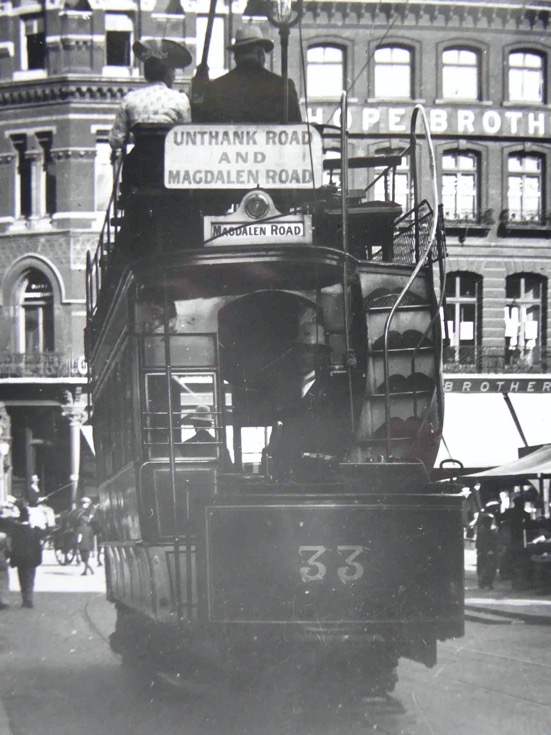
A rather unusual photograph of Tramcar No 33 descending Guildhall Hill around 1902/3, with both the conductor and the motorman apparently wearing pith helmets. Photo courtesy of the David Mackley Collection.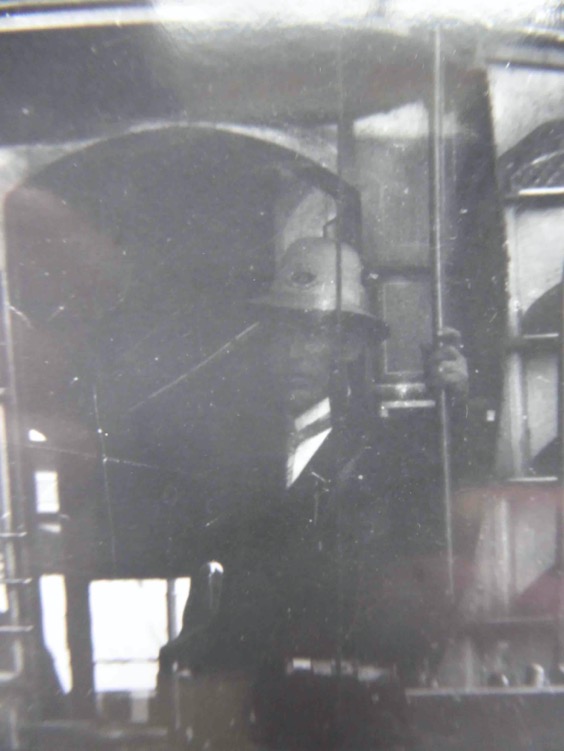
An enlargement of the above photograph showing the conductor, who is clearly wearing a white pith helmet with a standard NETCo cap badge. As this is the only photograph with staff wearing these helmets, and there are many from this era, it was more than likely a special occasion such as a carnival or festival.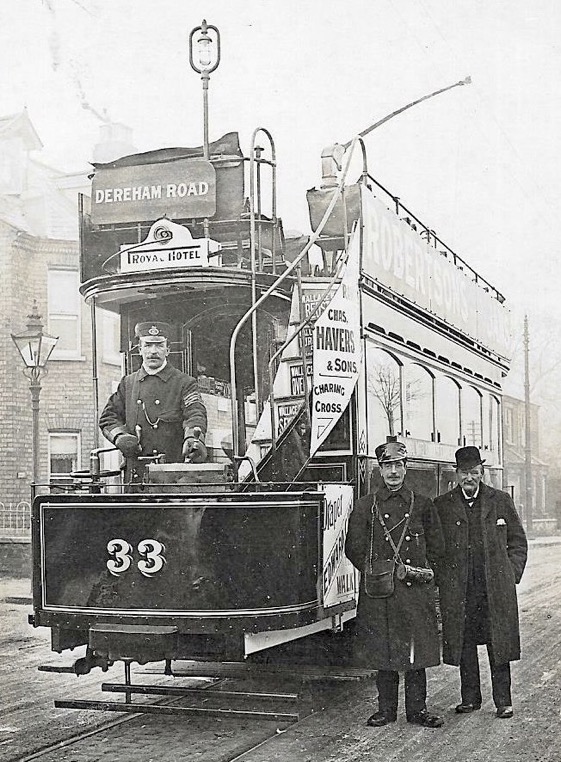
Tramcar No 33 standing at what is probably the Dereham Road terminus (with Merton Road off to the left) — photo undated, but probably taken around 1905/6 given that it it has a lifeguard and decency boarding. The conductor's drooping-peak cap appears to bear a waterproof cover, which is obscuring his cap badge, though the motorman, who had a more exposed position, doesn't have one. The motorman's greatcoat sleeve bears chevrons, the precise meaning of which is unknown, however, on many tramways they were used to indicate good conduct, longevity of service or seniority. Source unknown.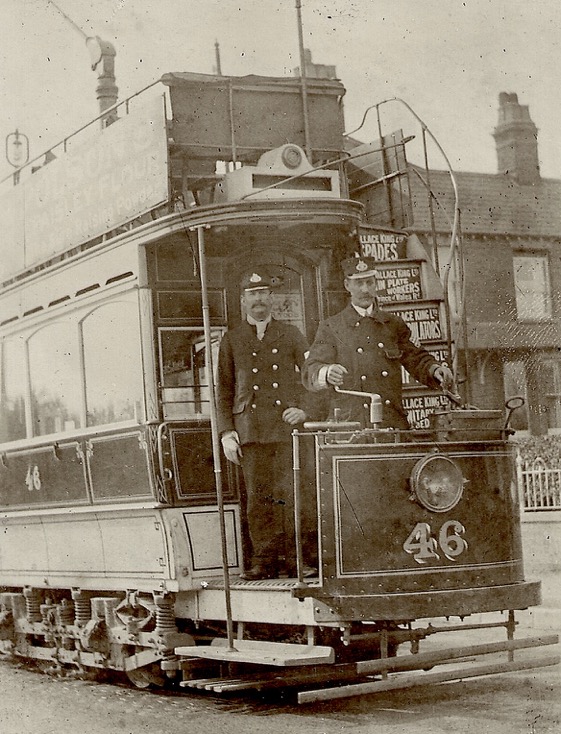
A conductor and a motorman pictured aboard Tramcar No 46 — photo undated, but definitely taken no earlier than 1906 when this former trailer car was converted to powered operation. Photo courtesy of the Stephen Howarth Collection.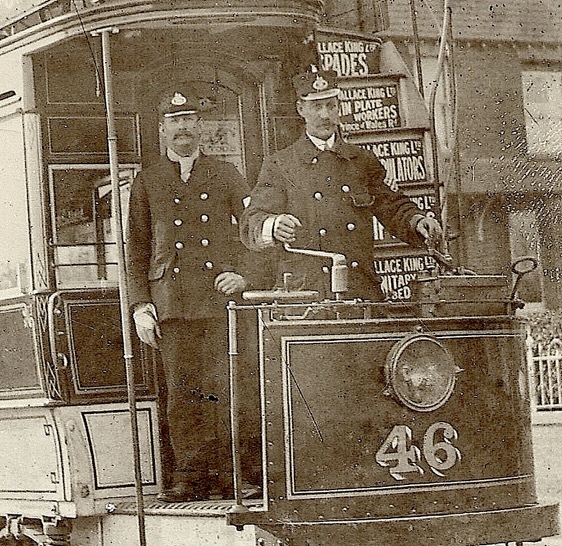
An enlargement of the above photograph showing the 'corporal'-like stripes on the left-hand arm of the motorman. 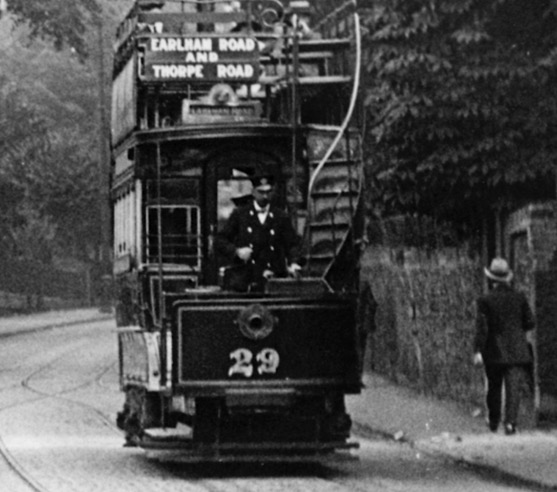
A motorman at the controls of Tramcar No 29 on an Earlham Road to Thorpe Road service — photo undated, but certainly taken prior to the Great War. Photo courtesy of the Tramways and Light Railway Society, with thanks to David Voice.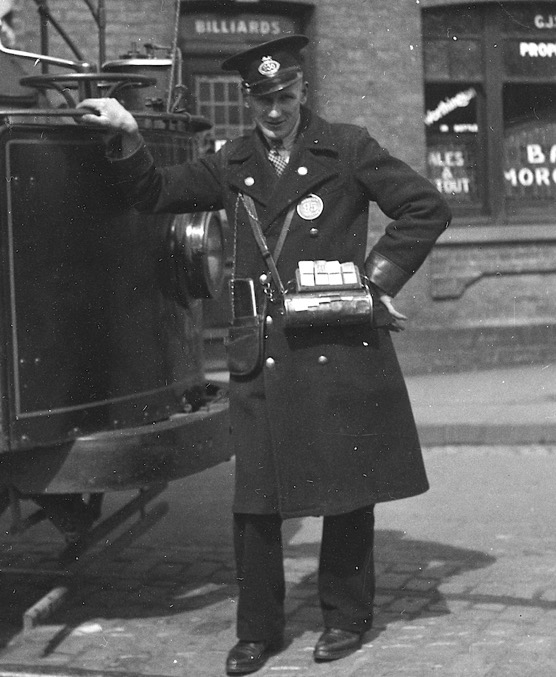
An excellent study of an NETCo conductor posing with his tramcar outside the 'Prince of Denmark' pub on Magdelen Road — photo undated, but probably taken in the late 1920s or early 1930s. With thanks to the National Tramway Museum. 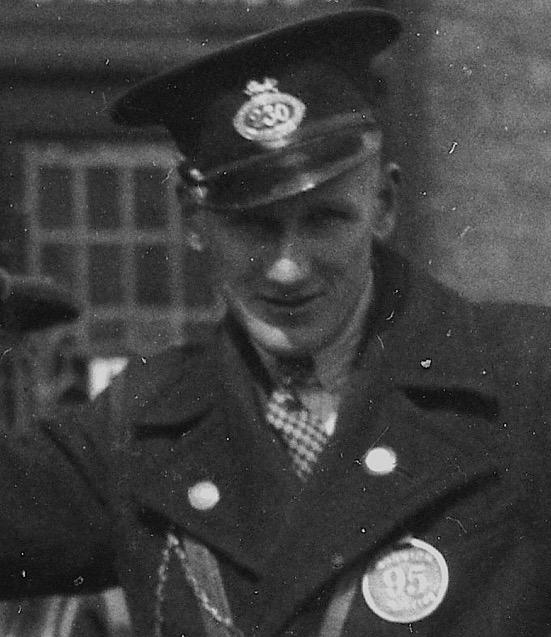
An enlargement of the above photograph, revealing the conductor to be Employee No 230, holder of Norwich Licence No 95.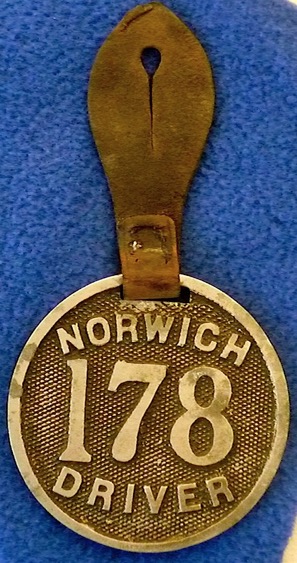
Norwich 'DRIVER' licence No 178 — light alloy. Author's Collection.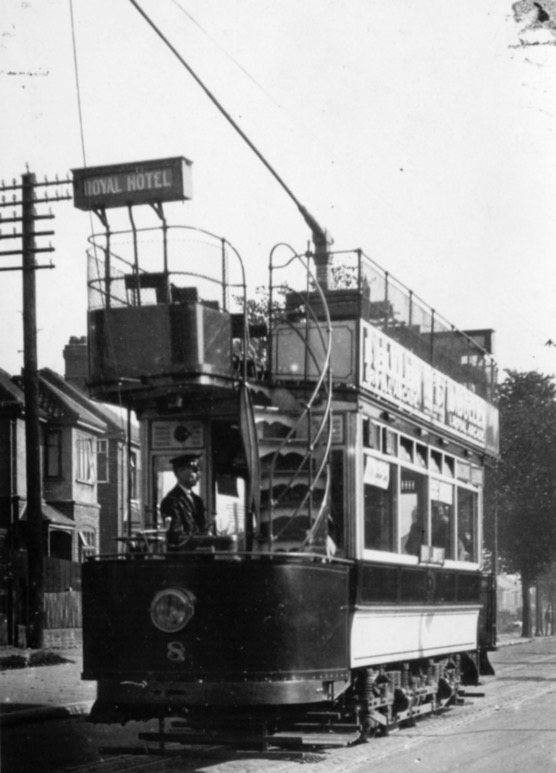
An unusual side profile of a motorman at the controls of Tramcar No 8 at the Dereham Road terminus — photo undated, but probably taken in the late 1920s or 1930s . Photo courtesy of the Tramways and Light Railway Society, with thanks to David Voice.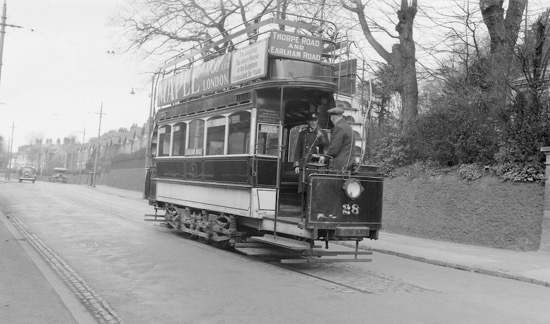
Tramcar No 28 stands at the Thorpe Road terminus on 16th April 1935. Photo by Dr H Nicol, courtesy of the National Tramway Museum. 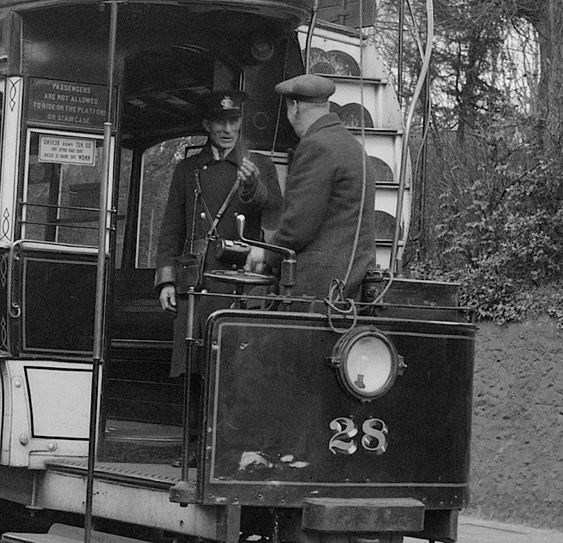
An enlargement of the above photograph showing the NETCo conductor in conversation with a member of the public on the platform.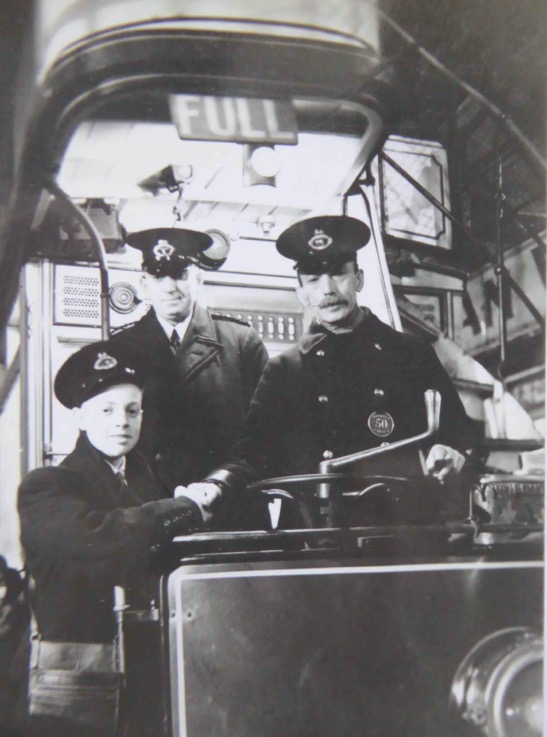
The driver of Norwich's last tram (No 10), George Hill, shakes the hand of the company's youngest conductor, Bernard Fisher — photo taken inside Silver Road depot on the 10th December 1935. The man behind them is Chief Inspector Hunter. Photo courtesy of the David Mackley Collection.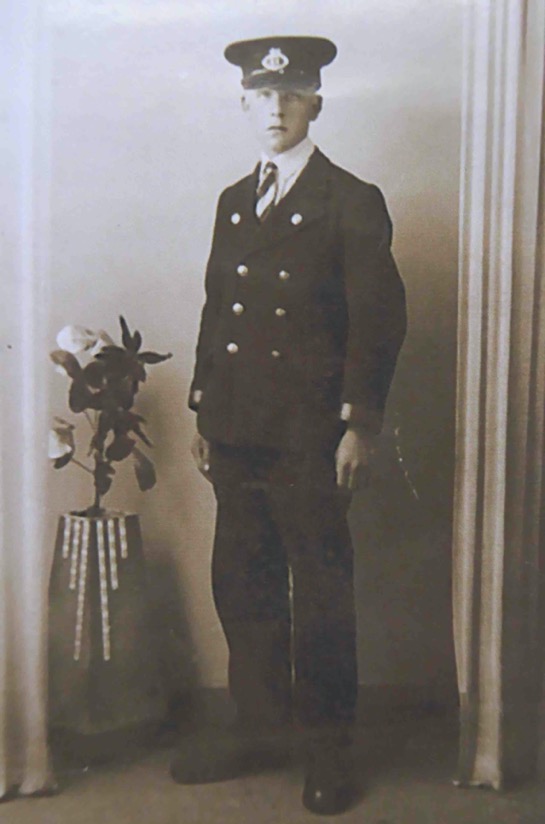
NETCo Employee No 11, Dan Carlton of Lakenheath (born 22nd March 1919, died 17th May 1973). Although undated, he started with the NETCo as a 14-year-old, so the photo was probably taken in the mid-1930s, and as such, probably reflects the style of uniform worn at the end of tramway operation. Photo courtesy of the David Mackley Collection.
Senior staff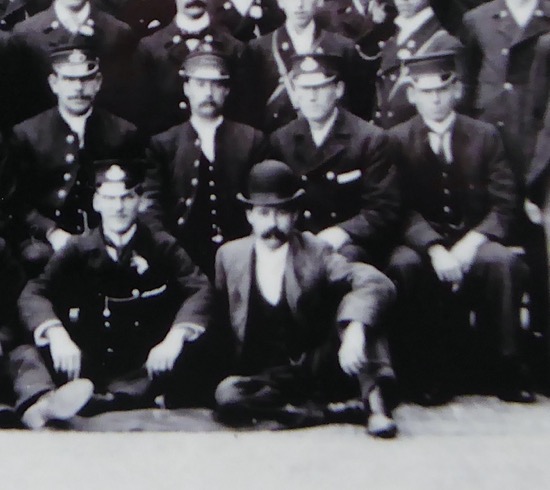
An enlargement of the 1900 depot staff photo above showing three individuals who are presumably senior staff. Whilst all are wearing single-breasted waistcoats and jackets, the latter with stand-up collars, they all have slightly different insignia on their drooping-peak caps. One has what looks to be a standard cap badge, another has a script-lettering grade badge (presumably embroidered), and the last man, who may possibly be the chief inspector (on the right) has no badge at all. In contrast to the tramcar staff, all three men have wide, piped hatbands.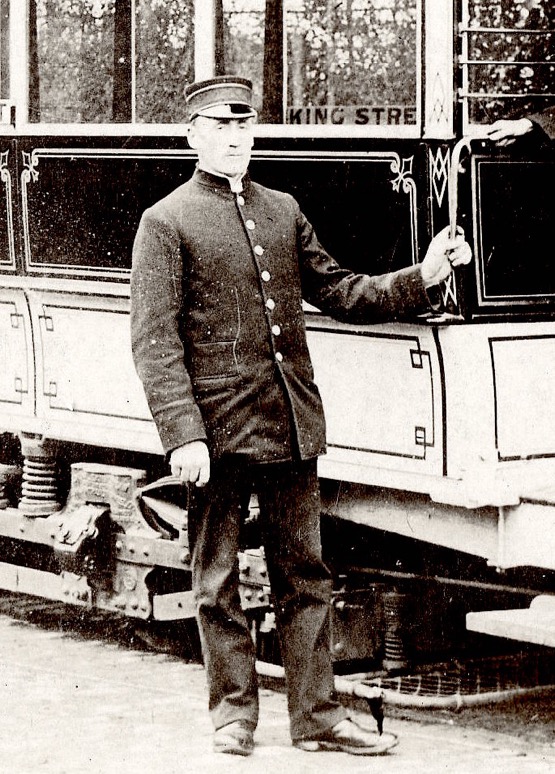
A blow-up of the 1900 shot of Tramcar No 32 above showing an individual who may well be the chief inspector. His uniform and cap are completely devoid of insignia, though his hatband is heavily embellished.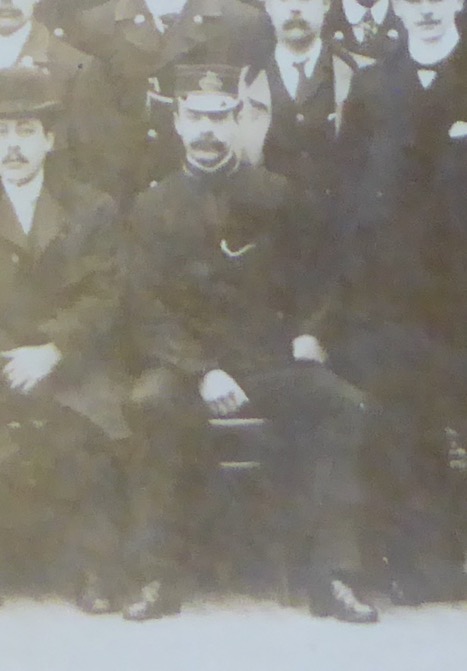
An enlargement of the c1901 Orford Place staff photograph above showing one of the inspectors. His collars probably carry his grade in embroidered script lettering.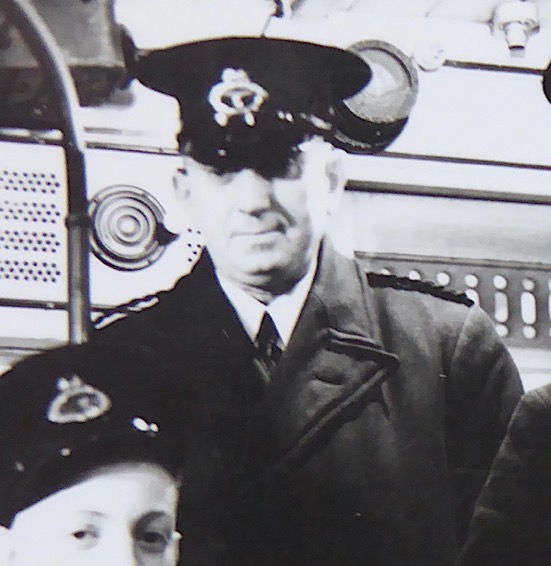
A blow-up of the last day photo above showing Chief Inspector Hunt. His badge, which had a gold finish (probably gilt), carried his grade — 'Chief Inspector' — on a red or green background.
Female staff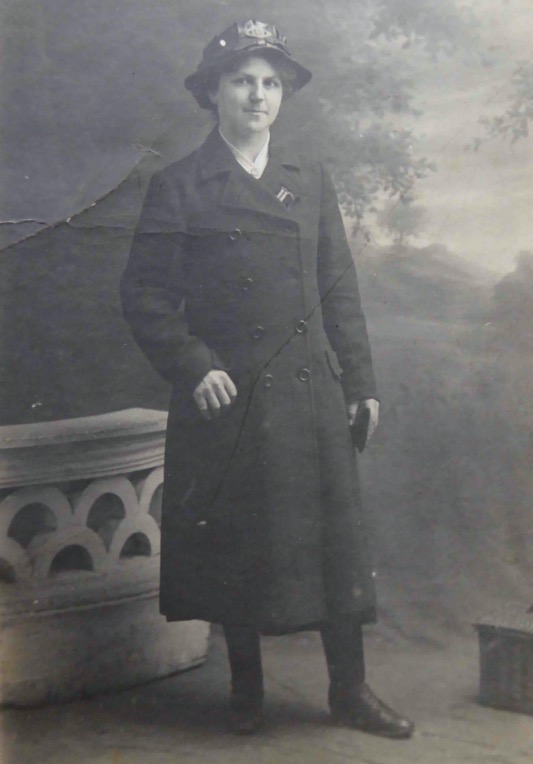
A lovely studio portrait of a Great War NETCo tram conductress purportedly taken in 1918, though the absence of a uniform suggests that it may have been taken before they were issued. Photo courtesy of the David Mackley Collection.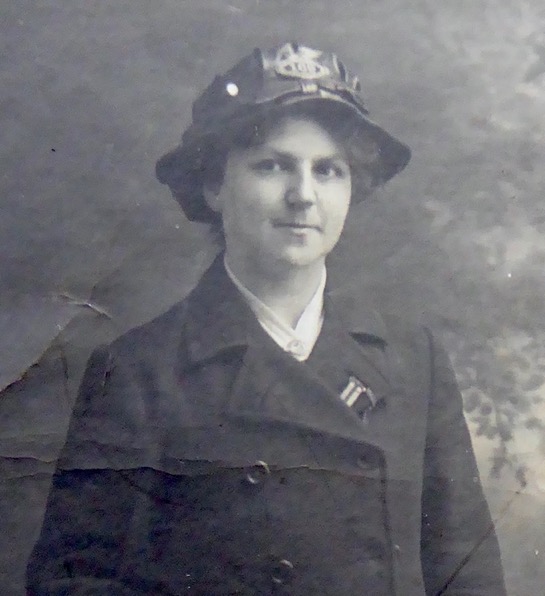
An enlargement of the above photograph showing details of her hat and coat. Although her topcoat would appear to be informal, it was certainly provided by the company as several other photographs have survived showing conductresses wearing them. The bonnet is a waterproof issue, and it clearly bears a standard cap badge, possibly Employee No 169.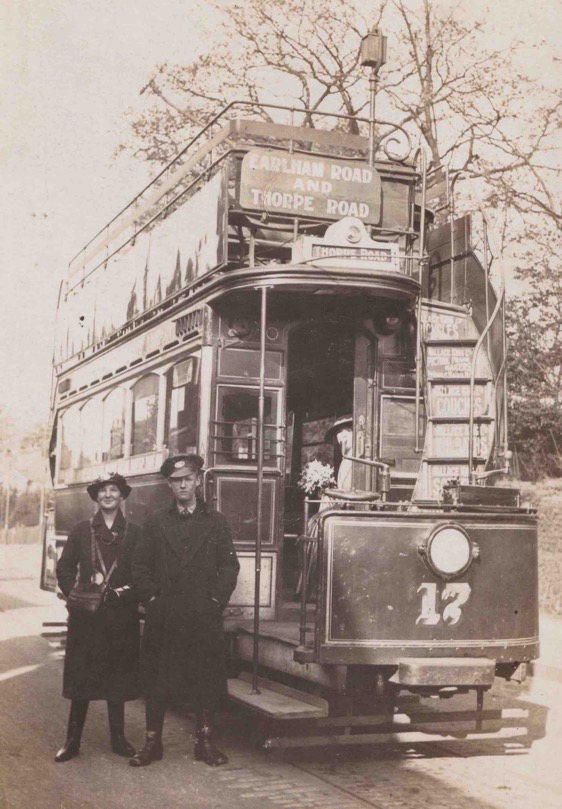
A conductress and a motorman with Tramcar No 17 in what is probably Earlham Road — photo undated, but almost certainly taken during the Great War. Author's Collection.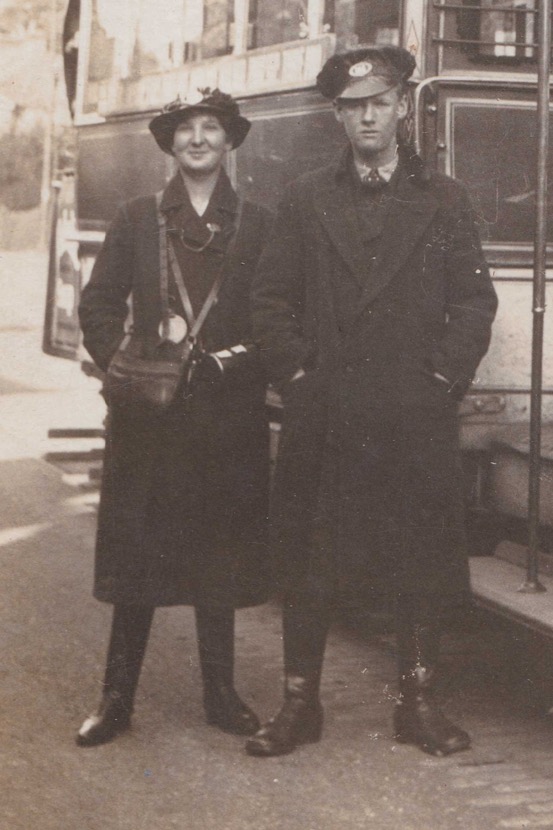
An enlargement of the above photograph showing the conductress and the motorman. The conductress's topcoat is identical in style to the one in the studio portrait above, strongly suggesting that they were company issued.
Another shot taken in Earlham Road during the Great War, this time of Tramcar No 8.
An enlargement of the above photograph showing the conductress, who is again wearing a plain, unmarked lancer-style, double-breasted topcoat, along with a waterproof bonnet bearing the standard cap badge.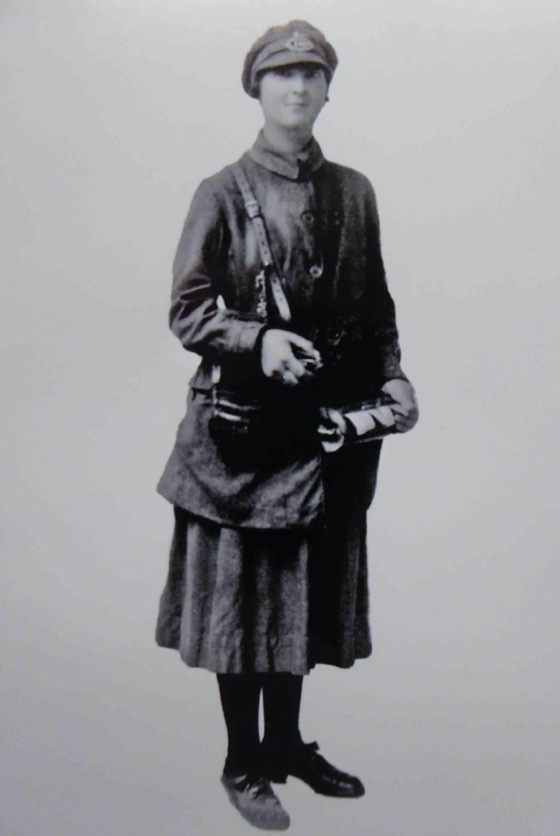
Another studio portrait of an NETCo conductress. In contrast to the first above, she is wearing a company-issued uniform, though completely unmarked save for the cap badge. Even the buttons are plain. Photo courtesy of the David Mackley Collection.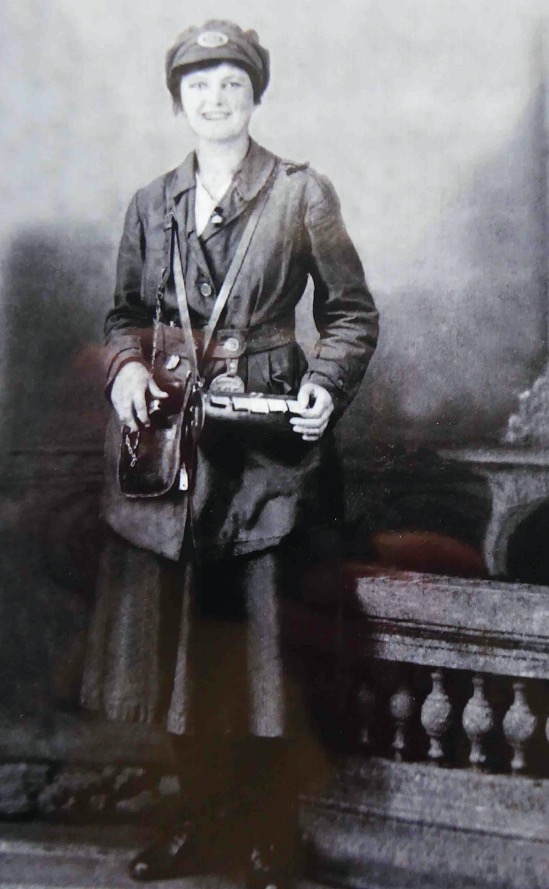
The conductress pictured here is clearly wearing a uniform, though once again, it is devoid of insignia or the usual marked buttons that the men's jackets bore. He peaked cap is of a type commonly referred to as a motro cap. Photo courtesy of the David Mackley Collection.